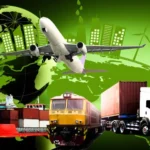Rail freight transportation is a fundamental pillar in the global logistics and supply chain network. This article provides a comprehensive analysis of the current state of the rail freight transportation market, exploring key trends, market dynamics, and challenges and offering insights into the future outlook.
Market Overview
Rail freight transportation is a critical component of the broader transportation and logistics industry, facilitating the movement of goods across vast distances. The market encompasses a diverse range of cargo, including raw materials, finished products, and commodities. Rail transport offers advantages such as cost-effectiveness, fuel efficiency, and environmental sustainability compared to other modes of freight transportation. The global rail freight transportation market is characterized by railroads and railways connecting key industrial hubs, ports, and distribution centers. It is pivotal in supporting various industries, from manufacturing and agriculture to retail and energy.
The approximate decision of the Techgolly market research team is the global Rail Freight Transportation market size was valued at least USD 250 billion in 2023 and continues to be projected to reach up to USD 351 billion by 2030. The growth will continue at a compound annual growth rate (CAGR) of 3% to 5% from 2023 to 2030.
Key Market Trends
The rail freight transportation market is experiencing several noteworthy trends:
Intermodal Transportation
Intermodal transportation, combining rail with other modes, such as trucking and shipping containers, is gaining traction. This integrated approach optimizes the efficiency of the supply chain, allowing for seamless movement of goods between different modes of transportation.
Technological Advancements
Digitalization and technology are transforming rail freight operations. Advanced tracking systems, predictive maintenance, and real-time monitoring enhance operational efficiency, reduce downtime, and provide greater visibility into the movement of goods.
Sustainable Practices
Environmental sustainability is a growing focus in the rail freight transportation market. Rail transport is inherently more energy-efficient and produces fewer emissions than road transport. Adopting green initiatives, electrifying railroads, and using cleaner fuels contribute to the industry’s commitment to sustainability.
Global Connectivity
Rail freight transportation facilitates global connectivity, connecting regions and countries through transcontinental rail networks. Initiatives such as the Belt and Road Initiative are expanding the reach of rail freight, providing efficient trade routes between Asia, Europe, and beyond.
Challenges
Despite its advantages, the rail freight transportation market faces certain challenges:
Infrastructure Investment
The need for significant infrastructure investment poses a challenge to developing and maintaining efficient rail networks. Upgrading tracks, expanding capacity, and implementing modern technologies require substantial financial commitments from governments and private entities.
Competition from Other Modes
Rail freight faces competition from other modes of transportation, particularly trucking and maritime shipping. The flexibility and door-to-door delivery capabilities of trucks and the global reach of maritime transport pose challenges to the rail freight industry.
Regulatory Hurdles
They are navigating regulatory frameworks and ensuring safety and environmental standards compliance present challenges for rail freight operators. Harmonizing regulations across regions and addressing regulatory barriers is essential for a seamless and efficient rail freight network.
Future Outlook
The rail freight transportation market holds several key developments for the future:
High-Speed Rail Freight
The development of high-speed rail freight services is on the horizon. These services aim to reduce transit times, enhance reliability, and offer a competitive alternative to air transport for time-sensitive cargo.
Integration of Autonomous Technologies
Autonomous technologies, including autonomous trains and automated logistics systems, are expected to play a significant role in the future of rail freight transportation. These technologies improve safety, optimize operations, and contribute to overall efficiency.
Continued Emphasis on Sustainability
The rail freight industry will continue to prioritize sustainability. Electrification of rail networks, the use of alternative fuels, and the implementation of eco-friendly practices will reduce freight transportation’s environmental footprint.
Conclusion
Rail freight transportation remains a cornerstone of the global logistics and supply chain ecosystem. The future outlook is optimistic as the industry embraces technological advancements, navigates challenges, and focuses on sustainability. The ongoing evolution of the rail freight transportation market is pivotal in supporting economic growth, trade, and the efficient movement of goods on a global scale. Navigating challenges and capitalizing on emerging trends will be essential for the industry to continue playing a vital role in the interconnected world of logistics and trade.










